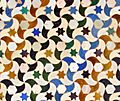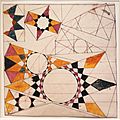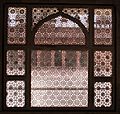Islamic geometric patterns facts for kids
Islamic geometric patterns were the first form of art in the Arabian Peninsula. Most forms of geometric patterns use shapes resembling hexagons, squares, and pentagons. They were originally invented by Euclid, who also invented geometry. They are ususally found on ceilings of churches, in colored or broken glass.
Images for kids
-
Somewhat geometric motifs such as the Wolf's Mouth (Kurt Aǧzi), to protect the flocks against wolves, are often woven into tribal kilims.
-
A tessellation of glazed ceramic tiles forming colourful geometric patterns in the Alhambra, Spain, which inspired M. C. Escher
-
Tessellations, arabesques and calligraphy on a wall of the Myrtle court, Alhambra, Granada, Spain
-
Tomb towers of two Seljuk princes at Kharaghan, Qazvin province, Iran, covered with many different brick patterns like those that inspired Ahmad Rafsanjani to create auxetic materials
-
Two-dimensional designs for two quarter-dome muqarnas – as a seashell (top), as a fan (bottom). Topkapı Scroll, 15th century
-
Analysis of octagonal patterns in Mughal architecture by Ernest Hanbury Hankin, 1925. 8-pointed stars emerge (lower right) where heavy black lines cross.
-
Decoration in Tomb of I'timād-ud-Daulah, Agra, showing correct treatment of sides and corners. A quarter of each 6-point star is shown in each corner; half stars along the sides.
-
Safavid bowl with radial and circular motifs, Persia, 17th century
-
Glazed tilework Girih at Shah-i-Zinda in Samarkand, Uzbekistan
-
Side of a wooden Minbar (pulpit) with 12-point stars. 14th century. Turkish and Islamic Arts Museum
-
Jali pierced stone screens at the tomb of Salim Chishti, Fatehpur Sikri, India
-
Iron gate with 10-point stars and kites at Al-Rifa'i Mosque, Cairo (1869–1912)
-
Geometric shabaka stained glass in the 1797 Palace of Shaki Khans, Azerbaijan
See also
 In Spanish: Patrones geométricos islámicos para niños
In Spanish: Patrones geométricos islámicos para niños




























